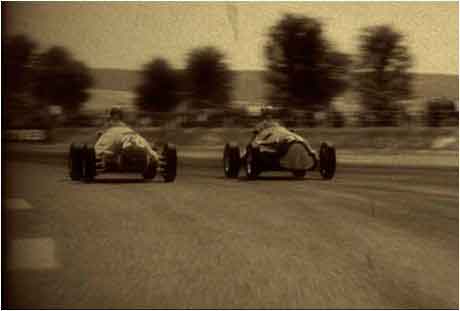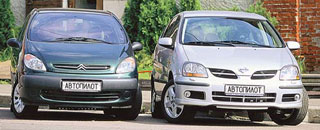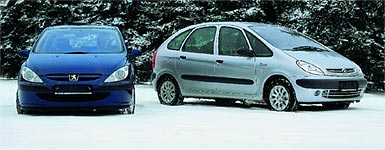Test drive Citroen Xsara Picasso 1999 - 2004 Minivan
Girl on the Ball
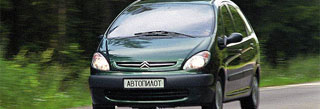 Want to be known as aesthet? Buy a Picasso picture. Want to follow automotive fashion? Buy Citroen Xsara Picasso
Want to be known as aesthet? Buy a Picasso picture. Want to follow automotive fashion? Buy Citroen Xsara Picasso The first appearance of the Citroen single -collar took place in 1998 at the Paris Motor Show. The automobile world was just starting to think about what the 21st century car would be, and Picasso was the first machine that really had a chance of serial production at the turn of the century, unlike numerous futuristic concepts. Citroen specialists conducted a serious study of the consumer market and decided that the car of the new century should be a multi -purpose, modulated, but still maintain the best qualities of a classic sedan - reliability, safety and ease of management.
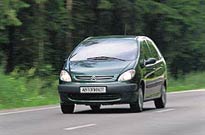 Goals and means. The opinion is subjective, but Citroen Picasso is really multifunctional. It is easy to move around the city-an economical engine, small dimensions, at the golf class level. It is pleasant to go on a trip - comfortable seats with armrests, a lot of light and space behind, an abundance of pockets and messages for small things. It is not a shame to come to work on this car - any reproach for Picasso’s non -fulfillment can be fended by an extravagant design of the car and earn the glory of aesthet and an extraordinary person among colleagues.
Goals and means. The opinion is subjective, but Citroen Picasso is really multifunctional. It is easy to move around the city-an economical engine, small dimensions, at the golf class level. It is pleasant to go on a trip - comfortable seats with armrests, a lot of light and space behind, an abundance of pockets and messages for small things. It is not a shame to come to work on this car - any reproach for Picasso’s non -fulfillment can be fended by an extravagant design of the car and earn the glory of aesthet and an extraordinary person among colleagues. The external and internal design of Picasso cannot leave indifferent. If you look at it on the side, then it all consists of smoothly curved lines - a continuous profile of wings and roof stretches, without interrupting, from the rear bumper to the front. The car looks like a drop of water, frozen after blowing through a straw. The huge area of \u200b\u200bglazing of the salon not only enhances this impression, but also creates a special mood among those sitting inside.
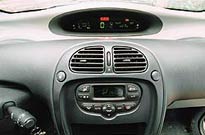 Extravagance inside is emphasized by the lack of a familiar combination of devices in the face of the driver - instead of it in the middle of the torpedo there is a large information display. In its left side, the information necessary only to the driver is displayed: the coolant temperature, fuel level and a huge digital speedometer. The right side of the display is associated with the triple-computer and draws information about the consumption of fuel, medium speed, temperature overboard. The first time is not quite familiar to fans of the classical style. But you get used to such an information system quickly, and it even begins to like it. And the gearbox switching lever resembles a computer joystick, the handle of which sticks out from a special thickening on the central console. But we have already seen this on some other minivans.
Extravagance inside is emphasized by the lack of a familiar combination of devices in the face of the driver - instead of it in the middle of the torpedo there is a large information display. In its left side, the information necessary only to the driver is displayed: the coolant temperature, fuel level and a huge digital speedometer. The right side of the display is associated with the triple-computer and draws information about the consumption of fuel, medium speed, temperature overboard. The first time is not quite familiar to fans of the classical style. But you get used to such an information system quickly, and it even begins to like it. And the gearbox switching lever resembles a computer joystick, the handle of which sticks out from a special thickening on the central console. But we have already seen this on some other minivans. 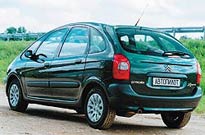 Domino principle. The modular construction of the internal space allows you to adapt the Picasso to momentary needs as much as possible - passenger transportation, a family trip, a long trip to the south, or just to a trip to the country on weekends. Actually, this is the main advantages of this machine.
Domino principle. The modular construction of the internal space allows you to adapt the Picasso to momentary needs as much as possible - passenger transportation, a family trip, a long trip to the south, or just to a trip to the country on weekends. Actually, this is the main advantages of this machine. Three rear seats have the same size - 44.5 cm. This is enough for the average passenger who does not abuse calorie food five times a day. In addition, the middle seat can be forwarded 14 cm forward - like a trifle, but in this situation you can not push your shoulders if there are three passengers from behind.
Picasso trunk volume is respect for - 550 cubic meters. Dm. And this is with indistinct rear seats. If there are many things, and there are few passengers, then you can fold the rear seats alternately, increasing the free space for the cargo. And for the transportation of long objects, any of the chairs can be removed at all. For example, when the average length of free space is removed, it increases to 2.35 m.
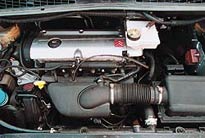 Exploring the inner space of the car, we realized that France is very tormented by thirst. Wherever you are inside Picasso, at the length of the outstretched arm there is a definition holder for a bottle with a caliber from 0.33 to 1.5 liters - in a small glove compartment under the joystic gearbox and in each door. Accordingly, holders or stamping for glasses are everywhere: in the lid of a voluminous glove compartment, in a recess in the middle of the dashboard, on folding tables on the backs of the front seats, on the back of the middle rear chair, which turns into a convenient table.
Exploring the inner space of the car, we realized that France is very tormented by thirst. Wherever you are inside Picasso, at the length of the outstretched arm there is a definition holder for a bottle with a caliber from 0.33 to 1.5 liters - in a small glove compartment under the joystic gearbox and in each door. Accordingly, holders or stamping for glasses are everywhere: in the lid of a voluminous glove compartment, in a recess in the middle of the dashboard, on folding tables on the backs of the front seats, on the back of the middle rear chair, which turns into a convenient table. We also liked the folding removable Modubox basket, fixed in the trunk and adapted for carrying 18 kg of cargo. Firstly, you can put the little things necessary on a long trip in it, and not take care that they will ride throughout the trunk. Secondly, with it you can elegantly walk around the market and buy products for a week-for convenience, the basket is equipped with a drawer with a handle and wheels.
Two glove boxes in front of the rear seats are very original - there are ZIPs in the left, the right is reserved for various little things that may be needed on the long journey.
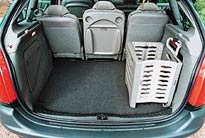 Tenth level. The driver's chair Picasso is adjusted in height, and if you put it on the floor and lower the steering column on the knees as much as possible, then you can sit in the car in a regular sedan. But in this case, the driver is located almost in the database, and it is not very convenient to manage Picasso-after all, this is a minivan, and you need to sit in it like on a bus is high and vertically. With this landing, the dimensions of the car are much better felt, and it is much easier to control the joystick of the checkpoint.
Tenth level. The driver's chair Picasso is adjusted in height, and if you put it on the floor and lower the steering column on the knees as much as possible, then you can sit in the car in a regular sedan. But in this case, the driver is located almost in the database, and it is not very convenient to manage Picasso-after all, this is a minivan, and you need to sit in it like on a bus is high and vertically. With this landing, the dimensions of the car are much better felt, and it is much easier to control the joystick of the checkpoint. At the idle speed of the engine, I simply can’t hear - I would like to write that only the fluctuations of the tachometer arrow indicate its work, but the tachometer in Picasso is not provided. The turns must be kept by ear. And the engine begins to make noise only at a speed of more than 80 km/h - with sharp acceleration, light detonation in the motor and aerodynamic noises from the mirrors appear. But this effect is observed in the silence of a salon, devoid of an audio system - even a quietly working Russian radio easily damps all extraneous sounds with Fomenko flat jokes.
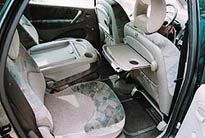 On the Picasso highway, it easily produces 150--160 km/h. But it is advisable to abuse such speeds only in long straight sections - in the turns of Citroen it begins to threateningly roll, and the rear wheels are clearly striving to go away from the asphalt. It is understandable - for the sake of comfort, the suspension of Picasso is long -term and provokes to the demolition of the rear axle in steep turns or a strong build -up of the body in conjunction of turns. But ... this car was created not for racing on a closed ring, but as a reliable family car. It is very easy to ride around the city, it goes well along the highway over long distances.
On the Picasso highway, it easily produces 150--160 km/h. But it is advisable to abuse such speeds only in long straight sections - in the turns of Citroen it begins to threateningly roll, and the rear wheels are clearly striving to go away from the asphalt. It is understandable - for the sake of comfort, the suspension of Picasso is long -term and provokes to the demolition of the rear axle in steep turns or a strong build -up of the body in conjunction of turns. But ... this car was created not for racing on a closed ring, but as a reliable family car. It is very easy to ride around the city, it goes well along the highway over long distances. Picasso had a slightly short -term second gear - as if the continuation of the first, on which they are touched. We tried a sinful business to switch immediately to the third, overclocking gear. In the free space, everything turns out perfectly - on the first they brought the motor to a nasty screech and higher and higher and higher. But in the city crowd, such a number does not pass - it does not work to pass the second program, and the potential owner of Picasso should be ready for the joystick he will have to turn, as at the tenth level of Doom.
And one more thing: the car in the end turned out to be not quite cheap. And, despite the small size, I would very much like to see a system such as parking in it - when you can park in a narrow space not by eye, but by sound. It is desirable that this is not the sound of a crippled bumper.
Text Nikolay Kachurin, photo Dmitry Lebedev
Source: "Autopilot"
Citroen Xsara Picasso 1999 - 2004
Citroen Xsara Picasso 1999 test drives - 2004
Citroen Xsara Picasso 1999 Krash Test - 2004
Krassh Test: Detailed Information27%
Driver and passengers
12%
Pedestrians







